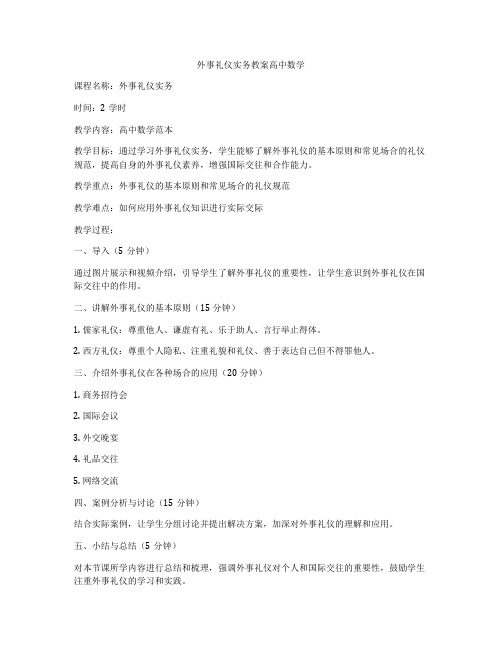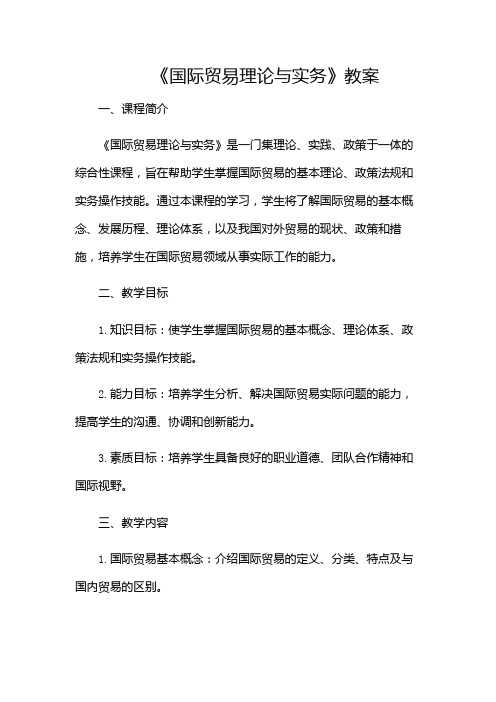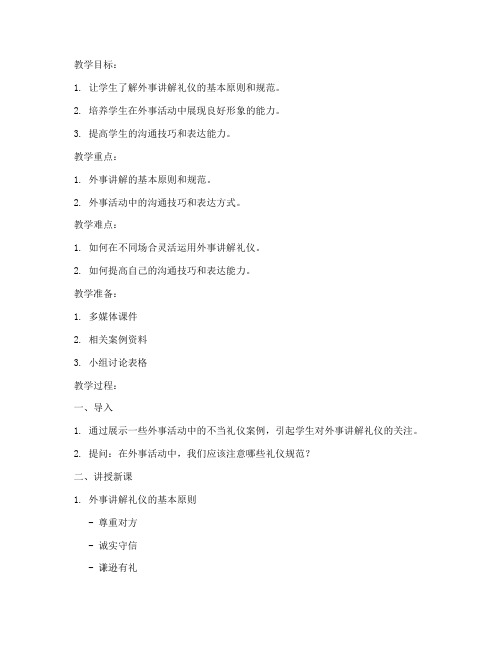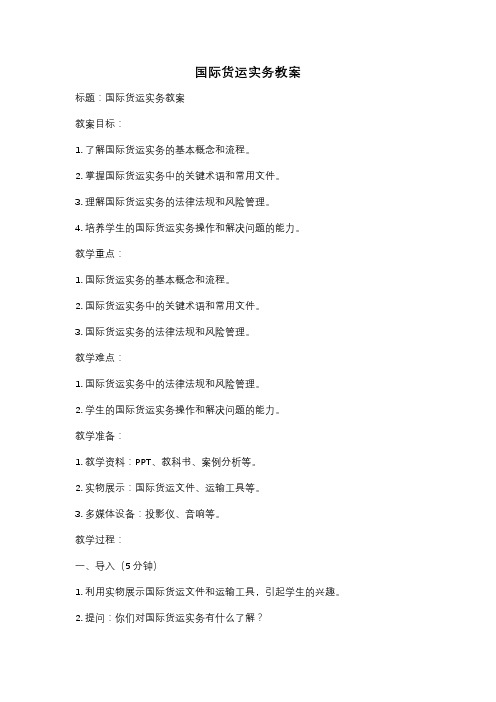外事实务(教案)
外事礼仪实务教案高中数学

外事礼仪实务教案高中数学
课程名称:外事礼仪实务
时间:2学时
教学内容:高中数学范本
教学目标:通过学习外事礼仪实务,学生能够了解外事礼仪的基本原则和常见场合的礼仪规范,提高自身的外事礼仪素养,增强国际交往和合作能力。
教学重点:外事礼仪的基本原则和常见场合的礼仪规范
教学难点:如何应用外事礼仪知识进行实际交际
教学过程:
一、导入(5分钟)
通过图片展示和视频介绍,引导学生了解外事礼仪的重要性,让学生意识到外事礼仪在国际交往中的作用。
二、讲解外事礼仪的基本原则(15分钟)
1. 儒家礼仪:尊重他人、谦虚有礼、乐于助人、言行举止得体。
2. 西方礼仪:尊重个人隐私、注重礼貌和礼仪、善于表达自己但不得罪他人。
三、介绍外事礼仪在各种场合的应用(20分钟)
1. 商务招待会
2. 国际会议
3. 外交晚宴
4. 礼品交往
5. 网络交流
四、案例分析与讨论(15分钟)
结合实际案例,让学生分组讨论并提出解决方案,加深对外事礼仪的理解和应用。
五、小结与总结(5分钟)
对本节课所学内容进行总结和梳理,强调外事礼仪对个人和国际交往的重要性,鼓励学生注重外事礼仪的学习和实践。
六、作业布置(5分钟)
布置学生阅读相关外事礼仪书籍或资料,选择一场合进行外事礼仪实践,并写一份实践报告。
教学反馈:
通过观察学生在课堂讨论和实践中的表现,收集学生对外事礼仪的理解和应用情况,及时纠正和指导学生,促进学生外事礼仪素养的提升。
外事实务导课

弱国无外交是谁提出来的?
诸葛亮 刘备白帝城临终托孤,可怜汪汪,又提出 子可辅,则辅之,如其不才,可自为成都 之主。结果,诸葛亮听后,寒流遍体,手 足失措,泣拜于地,曰:“臣敢不竭股肱 之力,尽忠贞之节,继之以死呼,弱国无 外交也。”
1945年曾有中国记者至比国采访陆征祥,据报 导陆征祥曾对未来国情提出简短而著名之警语: “弱国无公义,弱国无外交”。 陆征祥1871年生,1884年就读于上海广方言馆, 后入北京同文馆习外文,尤精俄文。1893年奉 派担任中国驻俄罗斯大使馆翻译官。 陆征祥能力出色,表现优异,在1906年升任中 国驻荷兰特命全权大使。 1912年共和革命后,应总统袁世凯电命,从驻 俄大使任所返国出任外交总长,并推动中国现代 外交机构之改革,将清代“外务部”改为外交部。 袁世凯称帝其间,曾短暂出任国务卿职务
甲午战争失败了,李鸿章也失败了。李鸿 章失败后,并没有灰心丧气,而是周游世 界。他是中国人中走得最远,走得国家最 多的中国文人与官吏。所到之处受到热烈 欢迎。他在这些欢呼中保持了冷静和尊严。 他更加广泛地了解了泰西诸国的政治,经 济,工业,人文,治世之道。与俄国建立 了联盟,也以实业做诱饵,博得了英,比, 德,法等国的好感,来华投资者渐多。
弱国无外交
对这句话你们怎么理解? 是谁提出来的?
弱国无外交是说一个国家自身不强大,其在国际 地位太低,不能受到其他国家的重视,难以与其 他国家建立平等的外交关系。 因为外交需要资本、利益、或制约对方的条件作 为筹码,越弱的国家拥有筹码越少,在外交中可 以打出去的牌不多(甚至没有),所以说弱国无 外交。 不是说弱小国家不能与其他国家建立外交关系, 而是说,在外交事务中没有重要作用。在国民党 时期,外交部长蒋廷黻的英语讲得非常好,发言 理直气壮,但是没有人听。日本外交部长英语很 蹩脚,言辞粗鲁,大家十分关注。美国总统罗斯 福很欣赏蒋廷黻,对他说:“你的英语讲得很好, 发言很有道理,但是你的国家太贫弱,弱国无外 交。”
国际贸易与实务管理知识教案

国际贸易与实务管理知识教案Lesson Plan Length: Approximately 2000 wordsObjective:- To introduce students to the basic concepts and principles of international trade and practical management.- To provide students with practical skills and knowledge in analyzing international trade policies and regulations.- To develop students' critical thinking and problem-solving skills in relation to international trade and practical management.Lesson 1: Introduction to International Trade (Approximately 45 minutes) Introduction:- Briefly discuss the importance of international trade in the global economy.- Explain the purpose and objectives of the lesson.Content:1. Definition and Importance of International Trade:- Define international trade and its significance.- Discuss the advantages and disadvantages of international trade.2. Comparative Advantage and Trade:- Explain the concept of comparative advantage.- Discuss how comparative advantage leads to specialization and trade.3. International Trade Theories:- Briefly introduce the following international trade theories:a. Mercantilismb. Absolute Advantagec. Comparative Advantaged. Heckscher-Ohlin Theorye. New Trade Theoryf. Porter's Diamond Model4. Barriers to International Trade:- Discuss the different types of barriers to international trade, including:a. Tariffsb. Non-tariff barriersc. Quotasd. SubsidiesActivity:- Divide the students into small groups.- Assign each group a specific international trade theory to research and present to the class. - Encourage discussions and questions during the presentations.Lesson 2: International Trade Policies and Regulations (Approximately 60 minutes) Introduction:- Recap the previous lesson on international trade theories.- Explain the purpose and objectives of the lesson.Content:1. Trade Policies:- Discuss the role of government in international trade.- Introduce the concept of trade policies and their objectives.2. Trade Agreements and Organizations:- Explain the role and functions of international trade organizations, such as:a. World Trade Organization (WTO)b. International Monetary Fund (IMF)c. World Bank Group3. Trade Policies and Regulations:- Explore various trade policies and regulations, including:a. Trade liberalizationb. Protectionismc. Dumpingd. Trade remedies4. Trade Disputes and Resolutions:- Discuss common trade disputes and their resolution mechanisms, including:a. Mediationb. Arbitrationc. Litigationd. Dispute Settlement Body (DSB) of the WTOActivity:- Conduct a case study analysis of a recent trade dispute, focusing on the trade policies and regulations involved.- Divide the students into groups and assign each group a different trade dispute to research and present to the class.- Encourage critical thinking and discussion by asking questions about the potential impacts and resolutions of the trade disputes.Lesson 3: Practical Management in International Trade (Approximately 55 minutes) Introduction:- Recap the previous lessons on international trade theories and trade policies.- Explain the purpose and objectives of the lesson.Content:1. International Business Environment:- Discuss the factors to consider when conducting international business, including:a. Political and legal environmentb. Economic environmentc. Cultural and social environment2. International Market Entry Strategies:- Introduce different market entry strategies for international trade, such as:a. Exportingb. Licensingc. Joint venturesd. Foreign direct investment3. International Supply Chain Management:- Explain the concept of supply chain management in an international context.- Discuss the challenges and considerations in managing international supply chains. 4. International Risk Management:- Identify common risks in international trade, including:a. Currency exchange rate fluctuationb. Political instabilityc. Regulatory changes- Introduce risk management strategies in international trade.Activity:- Divide the students into small groups and assign each group a specific international market entry strategy to research and present to the class.- Encourage discussions and critical analysis of the risks and benefits associated with each market entry strategy.Conclusion:- Recap the main concepts and principles discussed throughout the lesson.- Encourage students to reflect on the importance of international trade and practical management in the global economy.- Summarize the key takeaways from the lesson.Note: The lesson plan outline provided is a general guideline. Educators can adjust the content and activities according to the level and specific needs of the students.Lesson 4: International Market Research and Analysis (Approximately 60 minutes)Introduction:- Recap the previous lesson on practical management in international trade.- Explain the purpose and objectives of the lesson.Content:1. Importance of Market Research:- Discuss the significance of conducting market research in international trade.- Explain how market research helps in identifying market opportunities and challenges.2. Market Research Process:- Introduce the steps involved in conducting market research, including:a. Defining research objectives and target marketb. Collecting primary and secondary datac. Analyzing and interpreting datad. Drawing conclusions and making recommendations3. Market Analysis Tools:- Discuss the various market analysis tools used in international trade, such as:a. SWOT analysisb. PESTEL analysisc. Porter's Five Forces model4. International Market Entry Evaluation:- Introduce the criteria for evaluating potential international markets, including:a. Market size and growth potentialb. Competitive landscapec. Regulatory environmentd. Cultural and social factorsActivity:- Divide the students into small groups and assign each group a specific international market to research and analyze.- Instruct the groups to apply the market research process and analysis tools to evaluate the potential of their assigned market.- Encourage discussions and critical thinking in examining the market opportunities and challenges faced by each group.Lesson 5: International Trade Negotiation and Communication (Approximately 60 minutes) Introduction:- Recap the previous lesson on international market research and analysis.- Explain the purpose and objectives of the lesson.Content:1. Importance of Trade Negotiation:- Discuss the significance of trade negotiation in international trade.- Explain how effective negotiation skills can lead to favorable trade agreements.2. Trade Negotiation Process:- Introduce the steps involved in the trade negotiation process, including:a. Preparation and planningb. Opening statements and proposalsc. Bargaining and making concessionsd. Reaching an agreement3. Negotiation Strategies and Tactics:- Discuss various negotiation strategies and tactics used in international trade, such as:a. Win-Win negotiationb. Anchoring and framingc. Building relationships and trustd. Active listening and effective communication4. Intercultural Communication in International Trade:- Explain the importance of intercultural communication in international trade negotiations.- Discuss cultural considerations and communication styles in different international business contexts.Activity:- Conduct a role-play activity where students simulate an international trade negotiation scenario.- Divide the students into pairs representing different parties involved in the negotiation. - Instruct the pairs to apply negotiation strategies and tactics to reach a mutually beneficial agreement.- Encourage debriefing and reflection on the negotiation process and outcomes. Conclusion:- Recap the main concepts and principles discussed throughout the lesson.- Encourage students to reflect on the importance of effective market research, negotiation skills, and intercultural communication in international trade.- Summarize the key takeaways from the lesson.Note: The lesson plan outline provided is a general guideline. Educators should adjust the content and activities according to the level and specific needs of the students.。
《国际贸易理论与实务》教案

《国际贸易理论与实务》教案一、课程简介《国际贸易理论与实务》是一门集理论、实践、政策于一体的综合性课程,旨在帮助学生掌握国际贸易的基本理论、政策法规和实务操作技能。
通过本课程的学习,学生将了解国际贸易的基本概念、发展历程、理论体系,以及我国对外贸易的现状、政策和措施,培养学生在国际贸易领域从事实际工作的能力。
二、教学目标1.知识目标:使学生掌握国际贸易的基本概念、理论体系、政策法规和实务操作技能。
2.能力目标:培养学生分析、解决国际贸易实际问题的能力,提高学生的沟通、协调和创新能力。
3.素质目标:培养学生具备良好的职业道德、团队合作精神和国际视野。
三、教学内容1.国际贸易基本概念:介绍国际贸易的定义、分类、特点及与国内贸易的区别。
2.国际贸易理论:讲解绝对优势理论、比较优势理论、要素禀赋理论、国际贸易新理论等。
3.国际贸易政策与措施:分析关税政策、非关税壁垒、贸易救济措施、区域经济一体化等。
4.国际贸易实务:包括国际贸易术语、交易条件、合同签订、支付方式、货物运输与保险、进出口业务流程等。
5.我国对外贸易:介绍我国对外贸易的发展历程、现状、政策法规及发展前景。
四、教学方法1.讲授法:讲解国际贸易的基本理论、政策法规和实务操作技能。
2.案例分析法:分析国际贸易典型案例,培养学生分析、解决问题的能力。
3.讨论法:组织课堂讨论,激发学生的思维,提高学生的沟通、协调能力。
4.情景模拟法:模拟国际贸易业务操作,培养学生的实际操作能力。
5.实践教学:组织学生参观企业、实习等,提高学生的实践能力。
五、教学安排1.理论教学:共计32学时,每周2学时,连续16周。
2.实践教学:共计16学时,每周1学时,连续16周。
3.期末考试:共计2学时。
六、考核方式1.平时成绩:包括课堂表现、作业、小测验等,占比30%。
2.实践报告:占比30%。
3.期末考试:闭卷考试,占比40%。
七、教学资源1.教材:《国际贸易理论与实务》(作者,出版社,年份)2.参考文献:《国际贸易》(作者,出版社,年份)、《国际贸易实务》(作者,出版社,年份)等。
当代中国外交外事礼仪教学大纲(精品大学本科)

当代中国外交外事礼仪教学大纲(精品大学本科)第一篇:当代中国外交外事礼仪教学大纲(精品大学本科) 《当代中国外交》课程教学大纲一、课程基本信息课程代码:***********课程类别:专业必修课学时:总36学时;2学时/周学分: 2 适用专业:外交学、国际政治开课院(系):国际关系学院开课学期: 2011~2012学年第2学期二、课程性质和任务课程性质:本课程是外交学、国际政治专业学生的一门专业必修课。
课程任务:使学生了解1949年中华人民共和国成立以来中国对外关系发展演变的历史。
学习这门课程,可以使学生熟悉新中国对外关系发展的基本线索,了解新中国外交史上的重大外交事件,掌握中国政府在处理各类外交问题时的基本观点和立场,培养分析和解决外交及涉外问题的基本能力。
三、教学目标及教学要求教学目标:使学生掌握新中国成立以来中国对外关系的基本线索和阶段划分,使学生理解中国外交战略的演变:从“一边倒”、“两个拳头打人”、“一条线、一大片”、“独立自主的和平外交”、“韬光养晦、有所作为”、到“和平崛起、和平发展”。
了解新中国外交史上的重大外交事件,掌握中国政府在处理各类外交问题时的基本观点和立场,培养分析和解决外交及涉外问题的能力。
教学要求:本课程是一门历史性和现实性都非常强的课程,这就要求学生在学习过程中认真预习,阅读相关参考书籍和文章,了解新中国外交史上的重大外交事件,掌握中国政府在处理各类外交问题时的基本观点和立场。
要求学生平时多关注中国外交相关的新闻,并能够运用所学知识分析当前中国外交中的热点问题,使学生做到从历史与现实相互联系的视角来理解中国外交。
四、教学内容及学时分配第一章独立自主、保障安全(1949--1955)(5学时)第一节展现国家独立自主的外交品格和形象目的与要求:使学生掌握新中国成立前后,中国共产党在对外政策方面的重要决策及重大外交活动,并从中考察新中国是如何树立起独立自主的外交品格和形象的。
外事讲解礼仪教案模板及范文

教学目标:1. 让学生了解外事讲解礼仪的基本原则和规范。
2. 培养学生在外事活动中展现良好形象的能力。
3. 提高学生的沟通技巧和表达能力。
教学重点:1. 外事讲解的基本原则和规范。
2. 外事活动中的沟通技巧和表达方式。
教学难点:1. 如何在不同场合灵活运用外事讲解礼仪。
2. 如何提高自己的沟通技巧和表达能力。
教学准备:1. 多媒体课件2. 相关案例资料3. 小组讨论表格教学过程:一、导入1. 通过展示一些外事活动中的不当礼仪案例,引起学生对外事讲解礼仪的关注。
2. 提问:在外事活动中,我们应该注意哪些礼仪规范?二、讲授新课1. 外事讲解礼仪的基本原则- 尊重对方- 诚实守信- 谦逊有礼- 灵活应变2. 外事讲解礼仪的规范- 仪表端庄- 语言规范- 姿态得体- 注意细节3. 外事活动中的沟通技巧- 倾听对方- 准确表达- 适时提问- 保持礼貌4. 外事活动中的表达方式- 清晰简洁- 有条理- 有重点- 有感染力三、案例分析1. 展示几个外事讲解的成功案例,引导学生分析其成功之处。
2. 分组讨论:如何在实际工作中运用所学的外事讲解礼仪和技巧。
四、实践环节1. 学生分组,模拟外事讲解场景,进行角色扮演。
2. 教师巡视指导,对学生的表现进行点评。
五、总结与反思1. 教师总结本次课程的重点内容。
2. 学生分享自己在实践环节中的收获和体会。
教学评价:1. 学生对课程内容的掌握程度。
2. 学生在外事活动中的实际运用能力。
3. 学生在实践环节中的表现。
教案范文:一、教学目标让学生了解外事讲解礼仪的基本原则和规范,培养学生在外事活动中展现良好形象的能力,提高沟通技巧和表达能力。
二、教学重点1. 外事讲解的基本原则和规范。
2. 外事活动中的沟通技巧和表达方式。
三、教学难点如何在不同场合灵活运用外事讲解礼仪,提高沟通技巧和表达能力。
四、教学过程1. 导入:展示外事活动中的不当礼仪案例,引导学生关注外事讲解礼仪。
2. 讲授新课:讲解外事讲解礼仪的基本原则、规范、沟通技巧和表达方式。
国际货运实务教案

国际货运实务教案标题:国际货运实务教案教案目标:1. 了解国际货运实务的基本概念和流程。
2. 掌握国际货运实务中的关键术语和常用文件。
3. 理解国际货运实务的法律法规和风险管理。
4. 培养学生的国际货运实务操作和解决问题的能力。
教学重点:1. 国际货运实务的基本概念和流程。
2. 国际货运实务中的关键术语和常用文件。
3. 国际货运实务的法律法规和风险管理。
教学难点:1. 国际货运实务中的法律法规和风险管理。
2. 学生的国际货运实务操作和解决问题的能力。
教学准备:1. 教学资料:PPT、教科书、案例分析等。
2. 实物展示:国际货运文件、运输工具等。
3. 多媒体设备:投影仪、音响等。
教学过程:一、导入(5分钟)1. 利用实物展示国际货运文件和运输工具,引起学生的兴趣。
2. 提问:你们对国际货运实务有什么了解?二、讲解国际货运实务的基本概念和流程(15分钟)1. 讲解国际货运实务的定义和作用。
2. 介绍国际货运实务的基本流程,包括货物准备、运输方式选择、文件准备、报关报检、运输跟踪等。
三、介绍国际货运实务中的关键术语和常用文件(20分钟)1. 解释国际货运实务中常用的术语,如FOB、CIF、提单等。
2. 介绍国际货运实务中常见的文件,如商业发票、装箱单、提单等。
四、讲解国际货运实务的法律法规和风险管理(20分钟)1. 介绍国际货运实务中的法律法规,如国际货物买卖合同、国际贸易术语解释通则等。
2. 讲解国际货运实务中的风险管理,如货物损坏、丢失、延误等风险的预防和处理。
五、案例分析和讨论(20分钟)1. 提供实际案例,让学生分组进行分析和讨论。
2. 引导学生思考解决问题的方法和策略。
六、总结与拓展(10分钟)1. 总结本节课的重点内容。
2. 提出拓展问题,引导学生进一步学习和思考。
教学反思:1. 教学过程中要注意与学生的互动,引导他们积极参与讨论和思考。
2. 针对学生的不同水平和学习需求,灵活调整教学方法和内容。
外事礼仪实务教案模板范文

教学目标:1. 让学生了解外事礼仪的基本概念和原则。
2. 培养学生在外事交往中遵守礼仪规范的能力。
3. 提高学生的跨文化交际能力。
教学重点:1. 外事礼仪的基本原则。
2. 外事交往中的礼仪规范。
教学难点:1. 如何在不同文化背景下运用外事礼仪。
2. 如何处理突发事件中的礼仪问题。
教学过程:一、导入1. 提问:同学们,你们知道什么是外事礼仪吗?2. 学生回答,教师总结:外事礼仪是指在国际交往中,遵循一定的规范和原则,表现出的礼貌、尊重和谦逊的行为。
二、外事礼仪的基本原则1. 尊重原则:在国际交往中,要尊重对方的文化、习俗和信仰。
2. 谦逊原则:在外事交往中,要保持谦逊的态度,避免过于张扬。
3. 礼貌原则:讲究礼貌,注意言行举止,体现自己的修养。
4. 诚信原则:言行一致,言出必行,树立良好的信誉。
三、外事交往中的礼仪规范1. 问候与介绍:学会用适当的问候语,注意介绍顺序和称呼。
2. 座位安排:了解不同国家的座位礼仪,尊重对方的习俗。
3. 餐桌礼仪:掌握中西餐礼仪,注意餐具的使用和餐桌礼仪。
4. 赠送礼物:了解不同国家的礼物礼仪,避免送错礼物。
5. 演讲与会议:掌握演讲技巧,注意会议礼仪。
四、案例分析1. 教师展示不同文化背景下的外事交往案例。
2. 学生分组讨论,分析案例中的礼仪问题及处理方法。
五、实践演练1. 学生分组进行外事交往模拟演练。
2. 教师点评,指出学生的优点和不足,给予指导。
六、总结与反思1. 教师总结本节课的重点内容。
2. 学生分享自己的学习心得,反思自己的礼仪行为。
教学评价:1. 学生对外事礼仪的基本概念和原则的掌握程度。
2. 学生在外事交往中遵守礼仪规范的能力。
3. 学生跨文化交际能力的提高。
教学延伸:1. 邀请有外事经验的人士来校进行讲座。
2. 组织学生参加外事交流活动,提高实际操作能力。
- 1、下载文档前请自行甄别文档内容的完整性,平台不提供额外的编辑、内容补充、找答案等附加服务。
- 2、"仅部分预览"的文档,不可在线预览部分如存在完整性等问题,可反馈申请退款(可完整预览的文档不适用该条件!)。
- 3、如文档侵犯您的权益,请联系客服反馈,我们会尽快为您处理(人工客服工作时间:9:00-18:30)。
Unit 1 ReceptionTeaching Objectives:When studying this unit, Ss will learn about:●receiving people at the airport/hotel/company;●similarities and differences of addressing people in Chinese and Western cultures;●arranging initial meetings;●words and expressions used in receiving people.Teaching Difficulties:●how to arrange initial meeting appropriately.Teaching Methods: Explaining & PracticingTeaching Procedure:I. Lead-inWork with your partner and collect your thoughts on the following questions.1. Can you list some occasions in which you may receive people?2. Have you ever received any foreign guests? If so, describe your experience to your partner.3. How can you greet a foreign guest properly with his/her name and title?II. Situational DialogsDialog One: Meeting Your Guest at the AirportUseful sentences in Dialog One·Are you Mr. Miller from Shine Printing Company?·I am Zhao Jun from Collins Investment Company.·Just call me Jun.·This is my business card.·It’s nice meeting you.·Did you have a nice journey?·For business’ sake, I am a frequent flyer.·We’ve been looking forward to your visit.·I really appreciate your kind help and don’t know what I could have done without you.·If there is anything you need, just let me know.Additional sentences and structures·It’s a pleasure to meet you.·How was your flight/journey?·If there is anything you need, please don’t hesitate to tell me.·Is this your first trip to (China, etc.)?·Have you ever been to (China, etc.)?·I've heard so much about you. 久仰!·Long time no see.·It’s a long way to China, isn’t it? I think you must be very tired. 远道而来…·I hope you will have a pleasant stay here.·Mr. David Smith asked me to come here in his place to pick you up.·He meant to come here to meet you in person. But some other business held him back, so he asked me to come in his place.他本来打算亲自来接你,但是他因公务缠身,才由我替代。
·We have a car over there to take you to the hotel.·Our car is out in the parking lot.·Your valuable advice is most welcome. 欢迎多提宝贵意见。
·It's a rewarding trip! 不虚此行!·Please remember me to…·I will see myself out, please. 请留步,不用送了!Role playMake a dialog with your partner, taking the roles of Ms. Alexander and Wang Bing.Zhang Hong, Sales Manager of Fun Toy Manufacture Company, is supposed to pick up Mrs. Alexander, President of Smith Toy Retail Company in Britain, at the airport. Unfortunately, the flight is delayed for three hours and Zhang Hong has another appointment. Suppose you are Wang Bing, a colleague of Zhang Hong’s, and you are asked to meet Ms. Alexander at the airport. Get in touch with Ms. Alexander, introduce yourself, explain the absence of Zhang Hong and warm up your relationship by asking Ms. Alexander about her journey.Dialog Two: Helping Your Guest to Check inNotes·the Crowne Plaza Hotel: 皇冠假日酒店皇冠假日酒店是英国洲际酒店管理集团(IHG, Intercontinental Hotels Group)其中一个五星级品牌酒店,主要以商务会议为主。
洲际集团在中国目前有几个品牌酒店,分别为洲际假日酒店(Intercontinental Hotels & Resorts)、皇冠假日酒店、假日酒店(Holiday Inn)、假日快捷酒店(Holiday Express)。
Useful sentences in Dialog Two·Here we are at the Crowne Plaza Hotel…·May I help you?·I’d like to check in for the gentleman, please.·I have a reservation (with you) under the name of John Miller.·… we have a single-bed non-smoking room with a view to the Happy Valley Theme Park for you for three nights.·Here are the registration forms.·Would you please sign on the right hand corner at the bottom?·Our check-out time is 12:00 noon.·If you have any problem, please don’t hesitate to let us know.·Please enjoy your stay here.·In case that you need to book an air ticket or rent a car, an Airline Desk and a Car Rental Desk are available in the lobby.Additional sentences and structures·I have reserved a room in the name of…·We have a double-bed room/suite for you from May 1st to 3rd.·If there is anything you need, please don’t hesitate to contact us.·I hope you will have a nice stay here/find this hotel comfortable.·Have you any vacant (spare) room in the hotel? 旅馆里有空余房间吗?·I wonder whether you have any vacancies for tonight. 请问今晚有空房间吗?·Let me have a check.·I’m sorry, madam. We don’t have any vacancy at the moment.对不起,小姐,我们现在没有空房间。
·I'm sorry, but all our rooms are filled up. 对不起,所有的房间都住满了。
